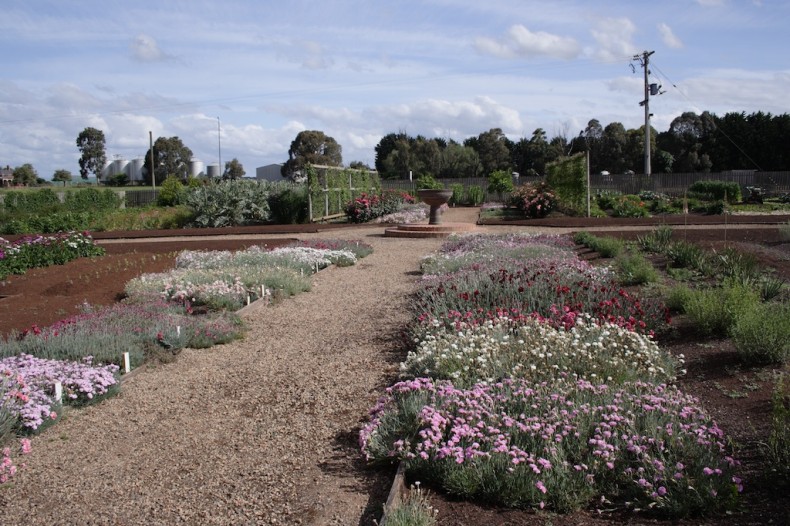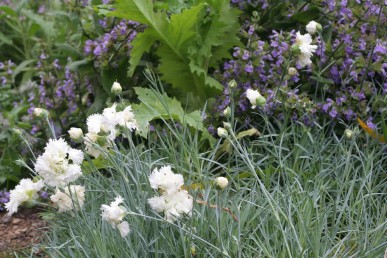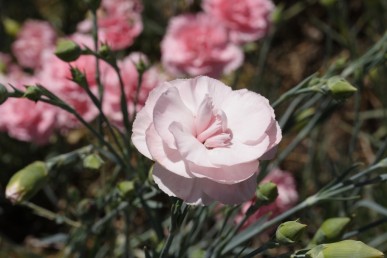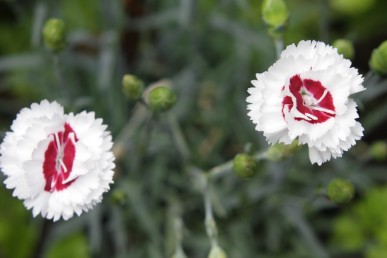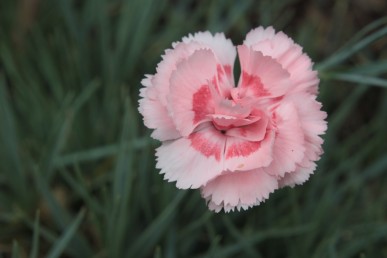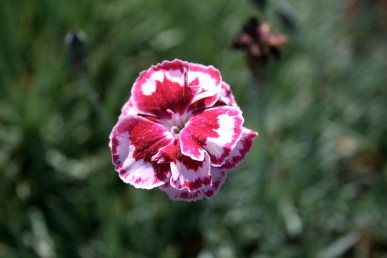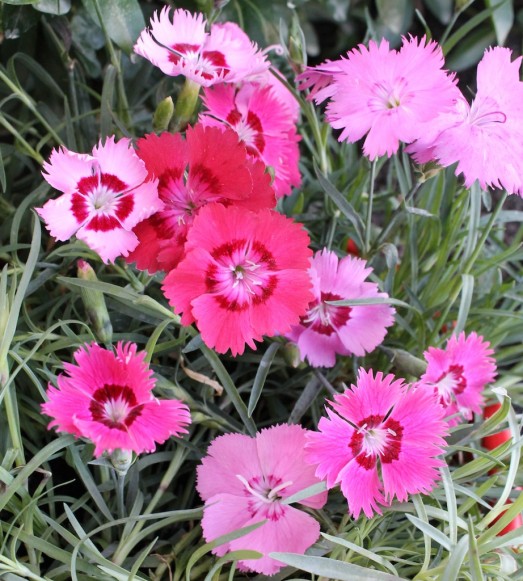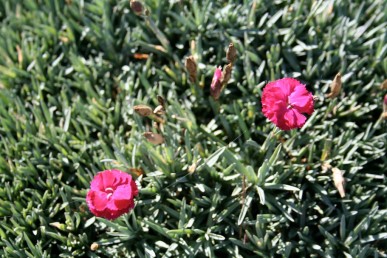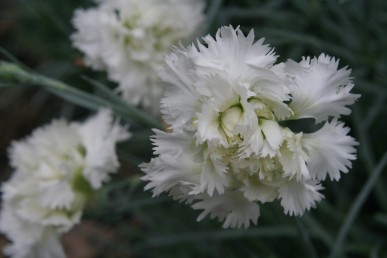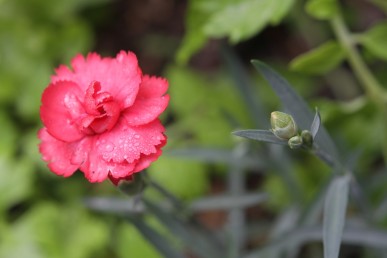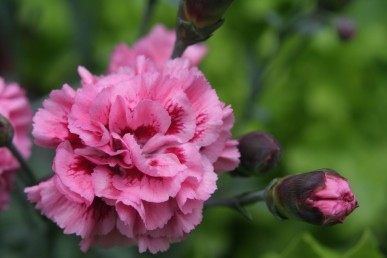Article and photos by Penny Woodward
Gillyflowers, carnations, pinks, sweet Williams, picotees, selfs and fancies, all names with which to conjure. These old-fashioned Dianthus species are all in the Caryophyllaceae along with well-loved flowers like gypsophila, herbs like soapwort and weeds such as chickweed. Heirloom Dianthus species and their more recent cultivars have been grown for their beauty and used in cooking and perfumery for hundreds if not thousands of years. The earliest recorded is probably D. caryophyllus, once known as gillyflowers and today more usually called carnations. In the first century AD, Pliny wrote that the clove carnation was discovered in Spain in the days of Augustus Caesar. Some of the varieties around in the 1700s had names like Lustie Gallant, Ruffling Robin and Fayre Maid of Kent.
Dianthus plumarius comes from eastern Europe and these plants were generally known as Pinks, the best known of which is probably Mrs Sinkins Pink (which is actually white with a beautiful clove scent). Sweet Williams are D. barbatus and are also well-loved and very old garden plants, D. grantianopolitanus is more commonly known as Cheddar Pink while D. deltoids is Maiden Pink. Over the years these species and others have been crossed and bred so that today there are many hundreds of different varieties and cultivars available with diverse and interesting names. These are usually labeled with the species name, Dianthus, followed by the cultivar name, such as ‘Coconut Sundae’ because with many it is no longer possible to be sure exactly which species they are derived from. Others will have their specific name followed by their cultivar name, such as D. grantianopolitanus ‘Flavora Rose Shades’. Today there are more than 30,000 cultivar names registered on the international Dianthus Register, but many of these lasted commercially for only a short time. The flowers of all the scented forms have been used in medicinal cordials and syrups, and can be added to sweets, puddings, salads and drinks.
In spring, and also in autumn, the Dianthus flowers in my garden look wonderful and this is why this flower is one of the flowers traditionally given to mothers on Mother’s Day. This special day is celebrated on the second Sunday in May and in the United States it was traditional to wear a carnation in recognition of your mother. If she was still alive then a red one was worn, if she was no longer living, then a white one. Some cultivars will flower right through summer too and some throw out a few flowers in winter as well.
How to grow
Dianthus plants are perennials (although there are also some annual bedding forms) that grow as low spreading clumps with linear leaves of a blue-green, silver or grey colour. The flowers are generally very fragrant with a delicious spicy, clove scent and can be single or double and the different varieties are pink, white, rose, purple and even yellow, with many combinations and shades in between.
Grow new plants by taking cuttings from non-flowering stems in spring or autumn, or from seed sown in spring, or by root division in autumn. Dianthus will grow in most soils but likes added compost, good drainage and an open sunny position. Add some lime if your soil is acid. They will also grow in a shady spot but won’t have as many flowers. They like some extra water during hot weather but are otherwise quite dry tolerant. Regularly cut back the dead flower heads as each flower dies back, to encourage more flowers. In a big clump, once most of the flowers have died, grab the hedge shears and cut all the flower heads off, so that just the leaves remain. This will often ensure a repeat flowering.
Dianthus are perfect as edges along garden beds and paths, they also grow well in containers of all sizes adding their fragrance and beauty to entertaining areas. They are especially good for small gardens where they can be tucked into odd corners. Dianthus will survive and even thrive in tropical and sub-tropical regions, but they grow best when planted in winter and must have very good drainage. They do best if planted in pots in a position that gets some protection from summer rains.
How to use
To use the flowers, pick them fresh and pull the petals from the flower heads. To dry them, either hang the flowers in bunches or pull the petals from the flower head and spread over brown paper. Always remove the petals from the calyx and for the best results you are supposed to snip off the slightly bitter white base. I find this tedious and time consuming, so don’t usually bother and haven’t noticed any difference.
Sprinkle fresh petals into or over vegetable and fruit salads, as well as soups and cold drinks. They are also frozen into ice cubes and added to your favourite drink, or stirred into desserts such as fruit jellies, ice-cream, cakes and custard. Petals can be made in syrups and cordials or infused in vinegars or wine. Dried flowers and petals add their delicious scent to scented sachets and potpourri. Once dried, petals can also be added to sugar to sweetly scent it
Dianthus also make wonderful cut flowers, spreading their fragrance around the home, and in the Language of Flowers (brought back into fashion by recent best selling novels) they can signify anything from refusal to pure and ardent love. A single flower means boldness, a double red pure and ardent love, a single pink pure love, white is ingeniousness and talent, while any variegated dianthus means refusal. So if you are going to dip your toes in these waters you will need to remember these meanings or risk offending!
The cultivars listed in the below have all been recently available from one or more of the mail order perennial nurseries listed. Some are old-fashioned cultivars that have been grown and used for hundreds of years, others are modern cultivars of old-fashioned species. But there are hundreds more available so have a look online at those available and choose what will suit you best.
Dianthus ‘Bella’
‘Bella’ grows as a mound of grey leaves with soft pink strongly clove scented flowers to about 40cm. It is tolerant of heat, dry and frost and flowers from spring to autumn.
Dianthus ‘Cherry Sundae’
Recently bred in the UK, this Pink comes originally from crosses between pinks and carnations, has large double flowers cherry red colour with white, fading to pink edges. Repeat flowering, neat silver foliage. Well-drained sunny spot, doesn’t mind it dry. 30cm x 40cm
Dianthus ‘Coconut Sundae’
Bred in the UK with a similar story to ‘Cherry Sundae’. This Pink has large double white flowers with a maroon eye. Very fragrant. Blue silver foliage with strong flower stems. Repeat flowering. 30cm by 50cm.
Dianthus ‘Doris’
This beautiful pale pink flowered dianthus is a cross between D. caryophyllus and D. plumarius bred nearly 100 years ago. Typically classed as a Pink, it grows to only 20cm, is very drought tolerant and makes a lovely cut flower.
Dianthus ‘Double North’
New Zealand bred from the old Maiden Pink D. deltoids, this Dianthus has neat mounds of blue-grey leaves, short branching flower stems and double white clove scented flowers.
Dianthus ‘Flavora Rose Shades’
These sweetly spicey flowers are bred from D.grantianopolitanus, the original Cheddar Pink, they grow to about 20cm and should be planted 20-30cm apart. The flowers come in different shades of pink, all on the one plant, and are single with delicately fringed edges.
Dianthus ‘Irene Shipp’
With lovely burgundy and cream almost single flowers, this dianthus grows from neat silver foliage to about 30cm. Most closely related to it’s ancestor Sweet Williams, flowers appear through much of the year, have a rich clove scent and tolerate frost, heat and dry conditions.
Dianthus ‘Katherine’
Fully double, very upright, flowers with pink fimbriated petals with a deep carmine centre. This is a beautiful heritage Pink with a delicious clove scent. The foliage is more blue than grey. 30cm x 30cm
Dianthus ‘Mars’
This old-fashioned English Pink has small double crimson flowers in late spring and a dense carpet of silver/grey green leaves. 15cm x 30cm
Dianthus ‘Mrs Sinkins’
A tried and true old-fashioned Pink cultivar from the 18th century, with pure white double flowers that are strongly clove scented.
Dianthus ‘Old Velvet’
Is an old-fashioned cross that dates from the 1700s with semi-double flowers, deep plum in colour with a white tracery. Green/grey leaves. 25cm x 25cm.
Dianthus ‘Rosebud’
Bred recently in the UK this Pink has coral pink/red flowers that are compact but very numerous and fragrant, with frilled petals on short stems. 30cm x 40cm
Dianthus ‘Sugar Plum’
Large, fragrant mid pink flowers with frilled edges and cherry coloured centres. This fairly new Pink has flowers appear from winter to late spring with plum coloured buds. 30cm x 40cm
Dianthus can be purchased from the following nurseries.
Lambley Nursery
Honeysuckle Cottage
Country Farm Perennials
Woodbridge Nursery
Diggers
Mistydowns

